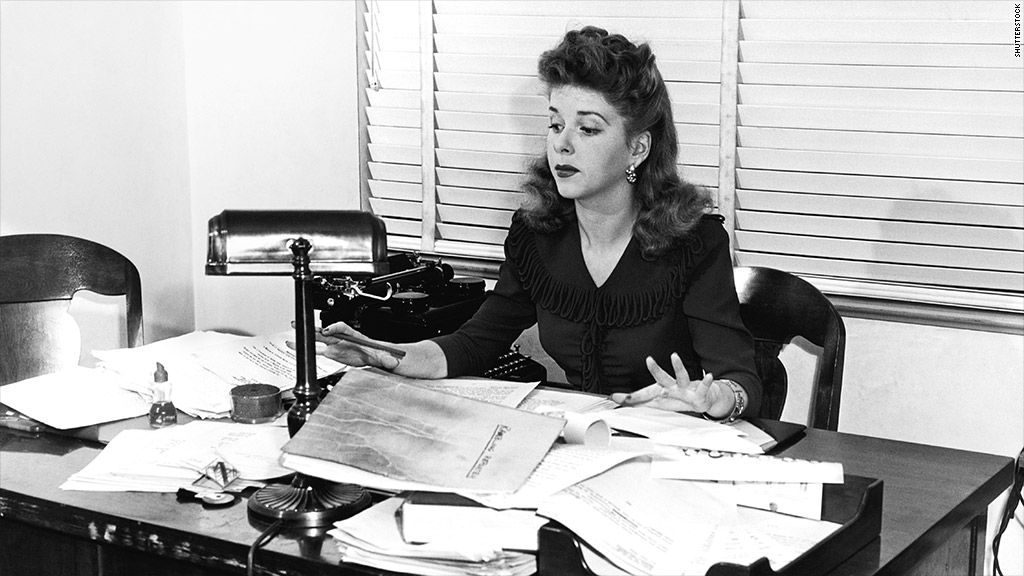
Sixty years ago, American women began heading off to the workplace in droves. But in the last couple of decades, that trend has completely stalled out.
"It seems that we are stuck," said Cornell University economist Francine Blau, who co-authored a paper on this topic with her husband Lawrence Kahn, also a Cornell economist.
 |
| Sweden's generous parental leave policies are a key reason why more women choose to work. Malin Lindahl of Sweden will take more than a year of maternity leave after having her first child, Emil, last October. |
What went wrong?
They point to a lack of family-friendly labor laws in the United States as a key part of the problem.
Why the U.S. is trailing
In 1950, only 37% of women ages 25-54 participated in the labor force -- meaning they had a job or were looking for one. The number rose rapidly, climbing to 74% by 1990. But then the progress stopped.
Today, still only 74% of women are active in the U.S. workforce, little changed in the last 25 years, and trailing far behind many other developed countries.
As of last year, America ranked 27th out of 37 developed countries for women's labor force participation, according to the Organization of Economic Cooperation and Development.
Related: Best countries for working parents
The United States remains the only major industrialized country in the world that doesn't mandate some sort of paid parental leave. The Family and Medical Leave Act, passed in 1993, entitles workers to 12 weeks of unpaid leave, but only applies to about 58% of American workers.
For example, the law doesn't cover employees of small firms, or workers who started their job less than a year before the birth of a child.
That contrasts with Germany, where women qualify for 14 weeks of maternity leave at full pay, regardless of the size of their employer. In France, Spain, the Netherlands and Austria, it's 16 weeks. And in countries like Canada, the United Kingdom and Denmark, paid maternity leave can extend for a year.
Share your story: Why do you choose not to work?
In Sweden, parents are entitled to at least 480 days of paid parental leave per child, which can be divided between both the mother and father. That's one reason why 88% of Swedish women participate in the labor force.
Malin Lindahl, 27, of Gothinburg, Sweden plans to take a year and a half off from her job as a teacher, after having her first child last October. She's not too worried about her career in the meantime. By law, the school has to hold the job for her.
"I put my job aside a little bit, and I enjoy relaxing and playing with my son," she said. "I know we have it very good in Sweden. I can't imagine being home just for 12 weeks."
More family-friendly U.S. workplaces?
While some family-friendly European laws were designed to improve the lives of parents, others had a much more utilitarian goal. Low fertility rates in Europe sparked fears about an unsustainable welfare system, with not enough young workers to support the aging population. Lawmakers hoped policies that promoted work-life balance would encourage more reproduction.
Birth rates haven't been a major issue in the U.S. That is, not until recently. Since the economic downturn in 2007, births have declined 8%.
"Some of the countries that have the very family-friendly policies have definitely been able to increase their birth rates, and to some extent, we may see ourselves wanting to go there too," said Heidi Hartmann, economist and president of the Institute for Women's Policy Research.
Related: Why secretary is still the top job for women
Hartmann points to rapidly rising child care costs and stagnant wages, as another key reason a lot of American women are choosing not to work.
Between 1985 and 2011, average child care costs rose 70% for working moms, after adjusting for inflation, according to the U.S. Census. Meanwhile, wages have barely budged.
While child care has also gotten more expensive in Europe, some governments subsidize the costs. Others reduce the need for child care, by giving parents the option to reduce their workload to a part-time schedule.

But American women aren't completely losing out. Blau and Kahn's research show that in spite of their lower labor force participation, women in the United States who do work are more likely to make it into professional and managerial roles. They're also more likely to work full-time, and as a result, earn more money over their lifetimes.
But that's not enough, according to Blau.
"We're losing the valuable resources of highly trained women," she said. "It's looking like we do have to break through this work-family barrier to significantly increase participation."


